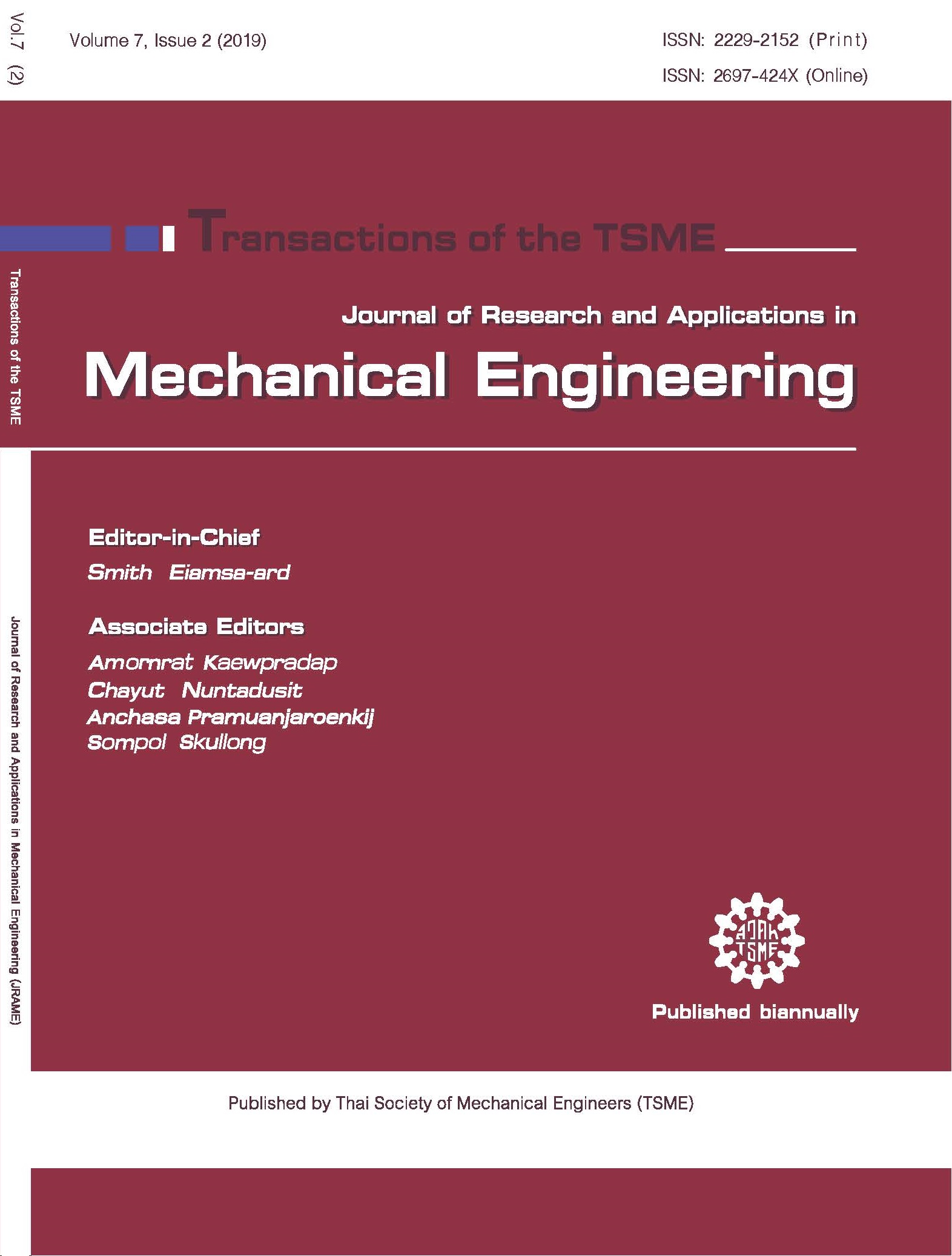Numerical analyses of micro hygro-mechanical behaviours of wood fibre reinforced composites
Main Article Content
Abstract
In spite of their relatively low manufacturing costs and enhanced mechanical properties, wood fibre-reinforced composite materials have a number of drawbacks regarding the long-term durability. One of which, as commonly known, arises from the hygroexpansion subjected to moisture uptake. Various experimental studies have been performed to investigate the mechanical behaviours in multi-scale while considerably less attempts on micromechanical studies are published. This research is presented to simulate the hygroelastic behaviours of wood fibre-reinforced composites in microscopic scale. Hygroelastic strains in orthotropic directions are accounted for. Weak formulation Finite Element Method for hygroexpansion of wood fibre constituent is developed and the algorithm is implemented using MATLAB. Input data in the model are model dimensions, elastic constants, densities of both constituents, fibre weight fraction, hygroexpansion coefficients of wood fibre and relative humidity. The simulation results exhibits reasonable agreements with the experiments - sorption tests of birch fibres-PLA matrix composite from previous studies, especially at low wood contents. The models also confirms structural failure caused by hygroexpansion. This model aims to be a preliminary design tool for creating wood fibre-reinforced composites exposed to high relative humidity. Further studies can be done to investigate debonding and cracking behaviours under wet-dry cycles.
Article Details
This work is licensed under a Creative Commons Attribution-NonCommercial-ShareAlike 4.0 International License.
References
[2] Rodrigues, C.S. and Pereira, M.A. The role of moisture and temperature variations in the accelerated weathering cycles for durability studies of cellulose-cement composites, paper presented in International Conference on Durability of Building Materials and Components 2011, Porto, Portugal.
[3] Cooke, A. Durability of autoclaved cellulose fiber cement composites, paper presented in 7th Inorganic-Bonded Wood and Fiber Conference, 2000.
[4] Mohr, B., Nanko, H. and Kurtis, K.E. Durability of kraft pulp fiber–cement composites to wet/dry cycling, Cement & Concrete Composites, Vol. 27(4), 2005, pp. 435-448.
[5] Klyosov, A. Wood-Plastic Composites, 2007, John Wiley & Sons, New York.
[6] Morrell, J.J., Nicoel, M.S., David, E.P. and Armando, G.M. Durability of wood-plastic composites, Wood Design Focus, Vol. 16, 2006, pp. 7-10.
[7] Laboratory-Forest-Product. Wood Handbook: Wood as an Engineering Material, 2010, United States Department of Agriculture Forest Service, Wisconsin.
[8] Nicole, S. Influence of moisture absorption on mechanical properties of wood flour-polypropylene composites, Journal of Thermoplastic Composite Materials, Vol. 14, 2001, pp. 421-432.
[9] Lindner, M. Factors affecting the hygroexpansion of paper, Journal of Materials Science, Vol. 53(1), 2018, pp. 1-26.
[10] Baldwin, J.D., Altan, C. and Rajamani, C.A. Structural analysis of an injection molded short-fiber-reinforced disk, Journal of Materials Processing and Manufacturing Science, Vol. 6(2), 1997, pp. 123-145.
[11] Dasgupta, A., Agarwal, R.K. and Bhandarkar, S.M. Three-dimensional modeling of woven-fabric composites for effective thermo-mechanical and thermal properties, Composites Science and Technology, Vol. 56(3), 1996, pp. 209-223.
[12] Stahl, D.C. and Cramer, S.M. A three-dimensional network model for a low density fibrous composite, J. Eng. Mater. Technol, Vol. 120(2), 1998, pp. 126-130.
[13] Termonia, Y. Structure‐property relationships in short‐fiber‐reinforced composites, Journal of Polymer Science Part B: Polymer Physics, Vol. 32(6), 1994, pp. 969-979.
[14] Xiaoshuang, X., Shirley, Z., Lin, H., Jefferson, Z., Xiang, L., Xiaojin, W. and Menghe M. Finite element models of natural fibers and their composites: A review, Journal of Reinforced Plastics and Composites, Vol. 37(9), 2018. pp. 617-635.
[15] Stålne, K. and Gustafsson, P.J. Three-dimensional model for analysis of stiffness and hygroexpansion properties of fiber composite materials, Journal of Engineering Mechanics, Vol. 128(6), 2002, pp. 654-662.
[16] Srubar, W.V. and Billington, S.L. A micromechanical model for moisture-induced deterioration in fully biorenewable wood–plastic composites, Composites Part A: Applied Science and Manufacturing, Vol. 50, 2013, pp. 81-92.
[17] Erik, T.J., Wernersson, L.G., Miettinen, A., Cris, L., Hendriks, L. and Gamstedt, E.K. Swelling of cellulose fibres in composite materials: Constraint effects of the surrounding matrix, Composites Science and Technology, Vol. 74, 2013, pp. 52-59.
[18] Almgren, K.M., Gamstedt, E.K. and Varna, J. Contribution of wood fiber hygroexpansion to moisture induced thickness swelling of composite plates, Polymer Composites, Vol. 31(5), 2010, pp. 762-771.
[19] Almgren, K.M., Gamstedt, E.K., Berthold, F. and Lindstro M. Moisture uptake and hygroexpansion of wood fiber composite materials with polylactide and polypropylene matrix materials, Polymer Composites, Vol. 30(12), 2009, pp. 1809-1816.
[20] Karmin, M. Wood-fibre composites: Stress transfer and hygroexpansion, 2010, KTH Fibre and Polymer Technology, Stockholm.
[21] Cousins, W.J. Elastic modulus of lignin as related to moisture content, Wood Science and Technology, Vol. 10(1), 1976, pp. 9-17.
[22] Al-Rumaithi, A. Fast Global Stiffness Matrix Assembly, MathWorks, MATLAB Central,
URL: https://www.mathworks.com/matlabcentral/fileexchange/70447-fast-global-stiffness-matrix-assembly, accessed on 13/4/2019
[23] Boresi, A.P., Schmidt, R.J. and Sidebottom, O.M. Advanced mechanics of materials, 5th edition, 1993, John Wiley & Sons, New York.
[24] Fung, Y.C. Foundations of Solid Mechanics, 1965, Prentice-hall, New Jersey.
[25] Kellogg, R.M. and Wangaard, F.F. Variation in the cell-wall density of wood, Wood and Fiber Science, Vol. 1969(3), 1969, pp. 180-204.
[26] Gamstedt, E.K. Modelling of effects of ultrastructural morphology on the hygroelastic properties of wood fibres, Journal of Materials Science, Vol. 42(24), 2007, pp 10254-10274.
[27] Skaar, C. Wood-Water Relations, 1988, Springer, Berlin.
[28] Persson, K. Micromechanical modelling of wood and fibre properties, 2000, Lund University, Sweden.
[29] Yew, G., Mohd, A., Yusof, Z., Ishak, M. and Ishiaku, U. Water absorption and enzymatic degradation of poly(lactic acid)/rice starch composites, Polymer Degradation and Stability, Vol. 90(3), 2005, pp. 488-500.
[30] Green, D.W., Winandy, J.E. and Kretschmann, D.E. Mechanical Properties of Wood, General technical report FPL, USDA Forest Service, 1999.
[31] Ugural, A.C. and Fenster, S.K. Advanced Mechanics of Materials and Applied Elasticity, 5th Edition, 2012, Pearson Education, London.



